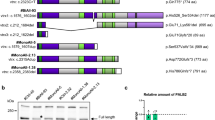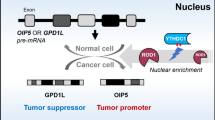Abstract
Medulloblastomas are highly malignant, poorly differentiated childhood tumours arising in the cerebellum. These tumors rarely lose TP53, which is the most commonly mutated gene in cancer. Recent work has shown that the basal level of p53 plays an important role in maternal reproduction by maintaining the expression of LIF in the uterus. Since LIF can maintain the undifferentiated state of stem cells we set out to ask if p53 regulates LIF in the human medulloblastoma cell lines DAOY and D283MED. We also used p53−/− and p53+/+ isogenic HCT116 colorectal carcinoma cell lines, already reported to exhibit p53-dependent expression of the LIF D transcript, to establish the extent of p53-dependency for LIF M and T alternative transcripts. Whilst all three known, full-length alternative transcripts are more abundant in p53+/+ cells, the alternative LIF M and T transcripts appear particularly sensitive to p53. In the p53 wild-type medulloblastoma cell line D283MED chromatin immunoprecipitation experiments showed p53 binding to the LIF gene. The mutant p53 expressed in line DAOY did not bind to this region or to the p21WAF1 p53 binding site. RNA interference against either WIP1 or SIRT1 stabilized p53 and enhanced the transcription of LIF in D283MED cells. Interestingly, siRNA against WIP1 or SIRT1 also induced increased apoptosis in the medulloblastoma line D283MED and, over a longer time period, in DAOY cells. We speculate that suppression of p53 function by combined WIP1-mediated dephosphorylation and SIRT1 deacetylation enables medulloblastoma cell survival but p53-dependent and independent apoptotic pathways remain intact. Thus small molecule inhibitors of SIRT1 may be useful in treatment of medulloblastoma.






Similar content being viewed by others
Abbreviations
- LIF:
-
Leukemia inhibitory factor
- ChIP:
-
Chromatin immunoprecipitation
- qRT–PCR:
-
Quantitative real time PCR
- STAT3:
-
Signal transducer and activator of transcription 3
- SIRT1:
-
Human Sirtuin 1 member of the silent information regulator 2 (Sir2) gene family
- WIP1/PPM1D:
-
Wild type p53-induced phosphatase 1/protein phosphatase magnesium-dependent 1 delta
- NAD+:
-
Nicotinamide adenine dinucleotide
- RNAi:
-
RNA interference
References
Gilbertson RJ (2004) Medulloblastoma: signalling a change in treatment. Lancet Oncol 5:209–218
Liu J, Gang Y, Guo L, Li H (1999) Expression of leukemia-inhibitory factor as an autocrinal growth factor in human medulloblastomas. J Cancer Res Clin Oncol 125:475–480
Williams RL, Hilton DJ, Pease S, Willson TA, Stewart CL, Gearing DP, Wagner EF, Metcalf D, Nicola NA, Gough NM (1988) Myeloid leukaemia inhibitory factor maintains the developmental potential of embryonic stem cells. Nature 336:684–687
Bauer S, Patterson PH (2006) Leukemia inhibitory factor promotes neural stem cell self-renewal in the adult brain. J Neurosci 26:12089–12099
Hambardzumyan D, Becher OJ, Rosenblum MK, Pandolfi PP, Manova-Todorova K, Holland EC (2008) PI3K pathway regulates survival of cancer stem cells residing in the perivascular niche following radiation in medulloblastoma in vivo. Genes Dev 22:436–448
Singh SK, Hawkins C, Clarke ID, Squire JA, Bayani J, Hide T, Henkelman RM, Cusimano MD, Dirks PB (2004) Identification of human brain tumour initiating cells. Nature 432:396–401
Nichols J, Davidson D, Taga T, Yoshida K, Chambers I, Smith A (1996) Complementary tissue-specific expression of LIF and LIF-receptor RNAs in early mouse embryogenesis. Mech Dev 57:123–131
Hu W, Feng Z, Teresky AK, Levine AJ (2007) p53 regulates maternal reproduction through LIF. Nature 450:721–724
Auernhammer CJ, Melmed S (2000) Leukemia-inhibitory factor—neuroimmune modulator of endocrine function. Endocr Rev 21:313–345
Yang F, Van Meter TE, Buettner R, Hedvat M, Liang W, Kowolik CM, Mepani N, Mirosevich J, Nam S, Chen MY, Tye G, Kirschbaum M, Jove R (2008) Sorafenib inhibits signal transducer and activator of transcription 3 signaling associated with growth arrest and apoptosis of medulloblastomas. Mol Cancer Ther 7:3519–3526
Haines BP, Voyle RB, Pelton TA, Forrest R, Rathjen PD (1999) Complex conserved organization of the mammalian leukemia inhibitory factor gene: regulated expression of intracellular and extracellular cytokines. J Immunol 162:4637–4646
Rathjen PD, Toth S, Willis A, Heath JK, Smith AG (1990) Differentiation inhibiting activity is produced in matrix-associated and diffusible forms that are generated by alternate promoter usage. Cell 62:1105–1114
Haines BP, Voyle RB, Rathjen PD (2000) Intracellular and extracellular leukaemia inhibitory factor proteins have different cellular activities that are mediated by distinct protein motifs. Mol Biol Cell 11:1369–1383
Adesina AM, Nalbantoglu J, Cavanee WK (1994) p53 gene mutation and mdm2 amplification are uncommon in medulloblastoma. Cancer Res 54:5649–5651
Castellino RC, De Bartoli M, Lu X, Moon S-H, Nguyen T-A, Shepard MA, Rao PH, Donehower LA (2008) Medulloblastomas overexpress the p53-inactivating oncogene WIP1/PPM1D. J Neurooncol 86:245–256
Lu X, Nguyen T-A, Moon S-H, Darlington Y, Sommer M, Donehower LA (2008) The type 2C phosphatase WIP1: an oncogenic regulator of tumor suppressor and DNA damage response pathways. Cancer Metastasis Rev 27:123–135
Brooks CL, Gu W (2003) Ubiquitination, phosphorylation and acetylation: the molecular basis for p53 regulation. Curr Opin Cell Biol 15:164–171
Parssinen J, Alarmo EL, Karhu R, Kallioniemi A (2008) PPM1D silencing by RNA interference inhibits proliferation and induces apoptosis in breast cancer cells with wild-type p53. Cancer Genet Cytogenet 182:33–39
Michael D, Oren M (1992) The p53 and Mdm2 families in cancer. Curr Opin Genet Dev 12:53–59
Luo J, Nikolaev AY, Imai S, Chen D, Su F, Shiloh A, Guarente L, Gu W (2001) Negative control of p53 by Sir2alpha promotes cell survival under stress. Cell 107:137–148
Vaziri H, Dessain SK, Ng Eaton E, Imai S, Frye RA, Pandita TK, Guarente L, Weinberg RA (2001) hSIR2(SIRT1) functions as an NAD-dependent p53 deacetylase. Cell 107:149–159
Langley E, Pearson M, Faretta M, Bauer UM, Frye RA, Minucci S, Pelicci PG, Kouzarides T (2002) Human SIR2 deacetylates p53 and antagonises PML/p53-induced cellular senescence. EMBO J 21:2383–2396
Ford J, Jiang M, Milner J (2005) Cancer-specific functions of SIRT1 enable human epithelial cancer cell growth and survival. Cancer Res 65:10457–10463
Zhang Q, Wang S-Y, Fleuriel C, Leprince D, Rocheleau JV, Piston DW, Goodman RH (2007) Metabolic regulation of SIRT1 transcription via a HIC1:CtBPcorepressor complex. Proc Natl Acad Sci (USA) 104:829–833
Lindsey JC, Lusher ME, Anderton JA, Bailey S, Gilbertson RJ, Pearson ADJ, Ellison DW, Clifford SC (2004) Identification of tumour-specific epigenetic events in medulloblastoma development by hypermethylation profiling. Carcinogenesis 25:661–668
Saylors RLI, Sidransky D, Friedman HS, Bigner SH, Bigner DD, Vogelstein B, Brodeur GM (1991) Infrequent p53 gene mutations in medulloblastoma. Cancer Res 51:4721–4723
Bunz F, Hwang PM, Torrance C, Waldman T, Zhang Y, Dillehay L, Williams J, Lengauer C, Kinzler KW, Vogelstein B (1999) Disruption of p53 in human cancer cells alters the responses to therapeutic agents. J Clin Investig 104:263–269
Fujimoto H, Onishi N, Kato N, Takekawa M, Xu X, Kosugi A, Kondo T, Imamura M, Oishi I, Yoda A, Minami Y (2006) Regulation of the antioncogenic Chk2 kinase b the oncogenic Wip1 phosphatase. Cell Death Differ 13:1170–1180
Castellino RC, De Bortoli M, Lin LL, Skapura DG, Rajan JA, Adesina AM, Perlaky L, Irwin MS, Kim JY (2007) Overexpressed TP73 induces apoptosis in medulloblastoma. BMC Cancer 7:127–142
Briggs KJ, Corcoran-Schwartz IM, Zhang W, Harcke T, Devereux WL, Baylin SB, Eberhart CG, Watkins DN (2008) Cooperation between the Hic1 and Ptch1 tumor suppressors in medulloblastoma. Genes Dev 22:770–785
Bulavin DV, Phillips C, Nannenga B, Timofeev O, Donehower LA, Anderson CW, Appella E, Fornace AJ Jr (2004) Inactivation of the Wip1 phosphatase inhibits mammary tumorigenesis through p38 MAPK-mediated activation of the p16(Ink4a)-p19(Arf) pathway. Nature Genet 36(4):319–320
Alcain FJ, Villalba JM (2009) Sirtuin inhibitors. Expert Opin Ther Pat 19(3):283–294
Acknowledgments
We are grateful to Dr Bert Vogelstein for the HCT116 p53 −/− and +/+ cell lines. We thank the members of the YCR p53 Research Unit for helpful discussions. This work was supported by Yorkshire Cancer Research Fund core funding to JM.
Author information
Authors and Affiliations
Corresponding author
Electronic supplementary material
Below is the link to the electronic supplementary material.
Supplementary Fig. 1
The LIF antibody shows a lower signal in LIF siRNA-treated HepG2 cells.A band of approximately 40 kDa is seen using antibodies against LIF; this signal is reducedmarkedly in cells treated with LIF D siRNA compared with a control siRNA transfection (laminA/C), transfection using the reagent only “oligofectamine” and untreated cells. An actin blot isincluded as a loading control (PDF 52 kb)
Rights and permissions
About this article
Cite this article
Baxter, E.W., Milner, J. p53 regulates LIF expression in human medulloblastoma cells. J Neurooncol 97, 373–382 (2010). https://doi.org/10.1007/s11060-009-0043-x
Received:
Accepted:
Published:
Issue Date:
DOI: https://doi.org/10.1007/s11060-009-0043-x




